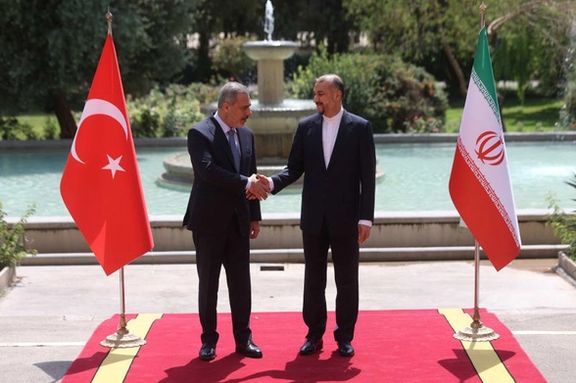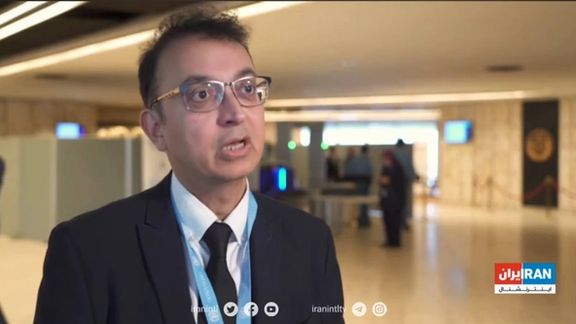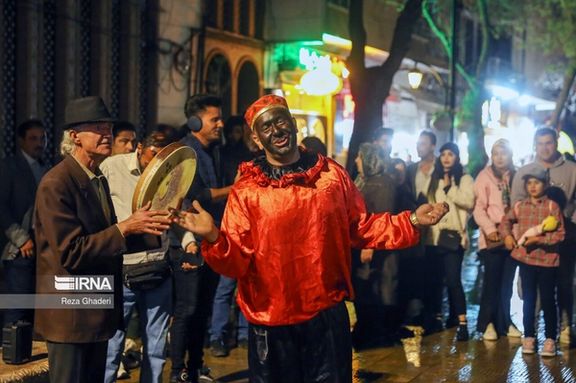11 Iranian Women's Rights Activists Sentenced To Over 60 Years

Eleven women's rights activists in Gilan province, north of Iran, who were detained in August, have been collectively sentenced to more than 60 years in prison.

Eleven women's rights activists in Gilan province, north of Iran, who were detained in August, have been collectively sentenced to more than 60 years in prison.
Mostafa Nili, the lawyer representing two of them, disclosed details on Wednesday. The women were each sentenced on charges including "membership in an illegal group," and “propaganda against the system."
Their arrests came just a month before the anniversary of Mahsa Amini's death in morality-police custody after being arrested for defying the mandatory hijab in September 2022.
The authorities often employ tactics such as arbitrary arrests, intimidation, harassment, and even violence to suppress opposition voices and maintain control. Human rights defenders, journalists, students, and members of minority groups are particularly vulnerable to persecution.
The government frequently justifies the crackdowns under the guise of national security or combating threats to the Islamic Republic's ideological integrity. Despite international condemnation and calls for reform, the Iranian regime continues to tighten its grip on civil liberties, creating a climate of fear and censorship that restricts freedom of expression and assembly within the country.
Since 2018, growing numbers of women have been arrested in Iran including activists, students, lawyers and even revolutionary insiders, such as Faezeh Hashemi, the daughter of former President Hashemi Rafsanjani, who criticized the regime or participated in protests.
Journalists have also suffered increasing crackdowns including the arrests of Niloofar Hamedi and Elahe Mohammadi, who were among the first to report the 2022 death of Mahsa Amini.
The regime has also imprisoned female lawyers who represented prominent activists, dissidents or political prisoners, according to the Center for Human Rights in Iran.
Rights group Amnesty International branded the crackdowns part of an "escalating crackdown to quash Iran’s civil society.” Lawyers and others affiliated with the Defenders of Human Rights Center advocacy group have been subjected to “excessive sentences and punishments for engaging in regular professional activities,” the organization said.

Pro-Iran Popular Mobilization Forces (PMF) of Iraq has given the green light to Baghdad and Ankara to eliminate the Kurdistan Workers Party (PKK) in Iraq.
Turkish Foreign Minister Hakan Fidan confirmed recent talks between Turkey and an official Iraqi institution funded by Baghdad, focusing on Sinjar, where the group has gained ground.
The news reflects Turkey's increasing involvement in Iraq, seeking to forge broader relations to quell longstanding tensions along its southern border, with the recent meeting held between the Turkish and Iraqi foreign ministers in Baghdad on March 13. Security officials, including PMF leader Faleh al-Fayyad and National Security Adviser Qasim al-Araji, were present.
Turkey expressed support for the formation of a 40-kilometer deep buffer zone aimed at eradicating the PKK, deemed a terrorist entity, stretching from Sulaymaniyah to the Syrian border via Sinjar.
Turkish President Recep Tayyip Erdogan is expected to travel to Baghdad in April. He is set to sign an agreement for the establishment of a joint operations command center and a buffer zone, according to Asharq Al-Awsat.
Meanwhile, Iraqi sources told the publication that with the presence of the PMF at the meetings, it signals Tehran's support for the Turks to act in Iraq.
According to the sources, Turkey's military plan calls for a broad operation in mountainous regions in the Kurdistan Region, while Baghdad provides intelligence support, maps and information and monitors the border.
Sulaymaniyah and Sinjar, however, lie on the outskirts of the Turkish buffer zone and intersect with Iranian interests, demanding that Ankara take different political and security arrangements over them.

While enjoying their long Norouz holiday, politicians in Iran have been reflecting on the country's economic, social and political crises and anticipating a bleak situation in the year ahead.
Their reflections on the past are primarily centered around the recent highly controversial election, which the country sees as a nightmare that it has partially left behind. However, as the holidays conclude, the nation anticipates the continuation of this nightmare with a run-up election in May.
The heavily manipulated vote for parliament on March 1 saw hardliners barring most other regime insiders from running for office. As a result, the election experienced the lowest turnout in 45 years, with widespread public apathy keeping a large majority of voters away from ballot boxes.
Khabar Online website in Tehran conducted brief interviews with ten Iranian political figures, seeking their perspectives on the best and worst events of the Iranian year that concluded on March 20.
Among the respondents, which included former lawmakers, a former state TV Chief (Mohammad Hashemi), and various politicians from different affiliations, the overwhelming consensus identified the March 1 election as the most adverse event of the past year.
Former judiciary head Sadeq Amoli Larijani, who lost the Assembly of Experts election in Mazandaran Province, and Majles Speaker Mohammad Bagher Ghalibaf were highlighted as notable losers. Ghalibaf, who secured over 1.2 million votes in 2021, saw a drastic reduction to just over 400,000 votes in 2024. However, respondents highlighted that almost everyone in the country could be considered a loser.

Reformist politician Gholam Ali Rajai expressed a sentiment shared by many, stating that even a destructive earthquake would have been preferable to the March 1 election. The devastation left behind by an earthquake could be compensated, but the losses caused by this election, which brought radicals to power, will have serious long-term consequences, he said.
Additionally, concerns were raised about the ongoing economic crisis under President Ebrahim Raisi's administration, as well as security issues highlighted by terrorist attacks in Shiraz and Kerman in the past year. Only one respondent, former presidential candidate Mostafa Hashemi Taba, singled out the government's neglect of environmental issues as the most significant failure of the past year.
When asked to grade the government's performance on a scale from zero to 20, opinions varied widely. While three hardline politicians, including Islamic Coalition Party member Hamid Reza Taraqqi, awarded grades between 14 to 18, others were far less generous, with two politicians assigning grades below 10, including two zeros.
Evaluating the performance of the outgoing parliament, except three hardline former lawmakers, the other seven respondents branded the parliament a total failure.
Meanwhile, three hardliners named the launching of a satellite to the space as the country's best event in the past year. Reformist Rajaei said winning the Nobel Peace Prize by jailed activist Narges Mohammadi was the best that happened to Iran last year.
Looking at the future, in another Interview, General Hossein Alai, a former commander of the IRGC naval Force and a reformist politician, said that the Islamic Republic needs to bring about a meaningful change in its economic and political policies and conduct.
Alai reiterated that significant changes are needed in the government's domestic and foreign policies as well as in the areas of economy and the way the government appoints its managers. He added that the government should do away with the arbitrary vetting of election candidates by the Guardian Council so that the people can believe that they can determine their own fate.

Canada's Foreign Interference Commission is set to decide on adding Iran to its list of foreign governments meddling in the country's internal political affairs.
In September, Canada launched a public inquiry into the interference of foreign governments, particularly Russia, China and India, in the country’s federal electoral processes and democratic institutions.
At its meeting on Wednesday, the commission hosted representatives of the immigrant communities from Iran, Russian, China and India.
Canada-based Iranian dissident Hamed Esmaeilion warned Iran should be included in the list of the countries to be investigated by the commission.
Esmaeilion, who attended the commission’s meeting as the representative of the families of victims who perished in the downing of a Ukrainian airliner by the IRGC in 2020, said, "Although Iran’s name is not yet on the list of the commission, I attended the meeting to discuss Tehran’s attempts to interfere with Canadian affairs."
He told Iran International that there are institutions affiliated with the Iranian regime which operate in Canada, saying, "These institutions are in the minority but try to influence Canada’s macro policies."
Should Iran be added to the list, Canada’s security and intelligence agencies will be obligated to provide the commission with confidential information so that it can decide about Iran’s possible role in Canada’s domestic policies, especially 2019 and 2021 elections.
In November, Microsoft’s Threat Analysis Center (MTAC) warned that Iran, Russia and China are likely to plan to influence the upcoming elections in the US and other countries in 2024.
Last month, Canadian-Iranian lawmaker, Ali Ehsassi, called for an inquiry about Tehran’s potential interference in the country’s elections.
“Given the catalogue of malign and illegal activities committed by the Islamic Republic of Iran on Canadian soil, it would be naïve to believe that the Iranian regime has any compunction to shape public opinion in Canada,” he said in a letter to the Foreign Interference Commission, calling for soliciting testimony and relevant documentation from Iranian-Canadians and others with a substantial interest in the proceedings.

Human rights monitoring groups concur that executions in Iran have reached unprecedented levels following the widespread protests of 2022, as indicated by figures compiled by these entities.
At least 767 Iranians were executed in the year ending March 2024, according to the Human Rights Activists News Agency (HRANA). That is more than double the figure for the year ending March 2022, when 333 were executed. Some human rights reports have mentioned a slightly higher numbers.
Many human rights activists say the executions have very little to do with justice and are designed primarily to ‘set examples’ and instill fear in the wider society to make it easier to control. At least eight people were hanged over trumped-up charges related to the nationwide protests of 2022, with several more protesters currently on death row.
A recent Amnesty International report further underscored the severity of the situation, revealing that from January 1, 2012, to July 31, 2023, over five thousand individuals, including at least 57 children, were executed in Iran.
It is widely believed that most executions in Iran are drug-related. There’s little trust in official accounts, however, since there’s no transparency and no real due process. So activists say they fear that the regime may use criminal charges as cover for political cases, especially if the accused is from the ‘periphery’ and lacks support networks to follow and publicize their case.
The United Nations special rapporteur on human rights in Iran has stated that the number of executions of ethnic and religious minorities in Iran is disproportionately high.

According to human rights watchers Hengaw, in 2023, about 4 out 10 of all executions have been Baluch (183) or Kurd (151). Both ethnic groups are highly active politically, and both played parts in the most recent wave of protests (2022) that was far greater than their size in Iran’s population.
Iranian judiciary officials routinely deny any conflation of dissent with criminal activity. When questioned by Western journalists about executions or human rights abuses, Iranian officials consistently maintain the official stance that the judiciary operates independently and is not answerable to the presidential administration.
While the latter claim holds some truth, the former does not. In reality, Iran’s judiciary primarily serves as a tool to suppress dissent, a role it has fulfilled since the inception of the regime in 1979. Even constitutionally, the judiciary lacks true independence, as its head is appointed and dismissed by the Supreme Leader.
It's no surprise, then, that the judicial system tends to align closely with the desires and directives of Supreme Leader Ali Khamenei.
In July 2022, prior to the widespread protests in Iran (now better known as Women Life Freedome uprising), Khamenei made a dark reference to the notorious 1980s, when thousands of political prisoners were executed summarily, often after one or two questions, without even a sham trial.
"Our God today is the same God of the 1980s," he said.
The judiciary got the message. So did human rights organizations and activists, many of whom warned of more executions on the horizon. And they seem to have been right.
In the year and a half that followed, executions soared – from 333 in the year ending March 2022 to 617 in the year ending March 2023 and to 767 in the past year.
This sharp rise brought the total executed in Iran in the last decade to around five thousand people, according to Amnesty International, among them at least 57 children.
In his November 2023 report to the United Nations General Assembly, UN secretary general Antonio Guterres warned of an “alarming” growth in the number of executions in Iran. Many inside and outside Iran echoed this sentiment, urging the Iranian regime to stop the “state killings”, with numerous protests organized worldwide.
Last month, Khamenei dismissed the international outcry, calling it “ some noise”, and labeling those executed as "criminals." He also made the most of the Palestinians’ plight. "Westerners who make a fuss over the execution of a criminal have closed their eyes to the massacre of 30,000 people in Gaza," he said.
That’s probably not far off the total number of executions in Iran under Khamenei’s rule – since 1989.

Despite the overlap of Norouz and Ramadan, many Iranians peacefully challenged the clerical regime by engaging in public celebrations, music, and dance, while also refusing to wear the hijab.
The convergence of Norouz holidays with the Islamic fasting month of Ramadan this year has heightened authorities’ frustration with celebrants. They are expected to be fasting and praying instead of participating in what is perceived as 'pagan' festivals involving song and dance.
Celebrants dance around the tomb of Cyrus the Great in Pasargadae.
Celebration of Norouz, and other ancient festivals such as Charshanbeh Souri (bonfire night before the New Year) is not officially banned. However, religious hardliners, who have complete sway over all centers of power now, consider these pre-Islamic festivals pagan and say celebrating them glorifies the pre-Islamic Persian history and paganism at the cost of Islam. For many Iranians, however, there is no contradiction between being Muslim and cherishing the country’s rich history and heritage.
Celebration of Norouz in Kurdish city of Boukan
Authorities typically attempt to prevent gatherings at ancient sites like Persepolis and the tomb of Cyrus the Great in Pasargadae during New Year celebrations and Charshanbeh Souri, often resorting to violence against participants.
This year, despite efforts by authorities, tens of thousands of Iranians headed to Persepolis and Pasargadae to celebrate the turn of the year and the Spring Equinox, which occurred at 6:36:25 local time on March 20. Officials confirmed that around ten thousand people managed to gather there, while reports on social media suggest that many others were halted on the road to Pasargadae.
This year too, tens of thousands of Iranians flocked to Persepolis and nearby Pasargadae, where the tomb of Cyrus the Great is located, to celebrate the turn of the year, the exact moment of the Spring Equinox, which fell at 6:36:25 local time on March 20 this year. Around ten thousand, according to officials, managed to gather there in time but many others were stopped on the road to Pasargadae as social media reports indicate.
Spontaneous dancing in Parsiyan
Elsewhere in Iran – including southern cities of Bushehr and Parsiyan, Shiraz and Isfahan, locals and holiday tourists staged spontaneous dances wherever possible, including at town markets and beaches.
In many other places, particularly in Kurdish towns and villages, such as Ney, a village of around 2,500 near the Kurdish city of Marivan, huge crowds of people have been celebrating Norouz outdoors, with song and dance and bonfires in the past few days.
Participants in Norouz celebrations in Ney village chant Woman, Life, Freedom
According to Hengaw Human Rights Organization, a Kurdish rights group, in Kermanshah, capital of a western province of the same name with a very large Kurdish population, security forces shot and wounded two young Kurdish men, Arman Basiri and Mohammad Ahmadian, on March 21 for merry making at a park.
Hengaw has reported that the victims who sustained serious injuries in the legs have been hospitalized and are under security guard.
Security forces attacking celebrants in Bolbolanabad village
In Bolbolanabad, a village of around 3,600 in Kermanshah Province, security forces also attacked the crowd which included hundreds of children. In a video posted on social media gunfire is also heard.
Stressing that eating and drinking in public is prohibited during Ramadan, Governor of Kermanshah Mohammad-Tayeb Sahraei on Monday said people have a right to display happiness, “but our Islamic beliefs and guarding the modesty and chastity of Kurdish women is a red-line for us,” he added, referring to women’s participation in dances.
Young people dancing on the street in Shiraz
An official of the governor’s office in the same province on Sunday claimed that “anti-Iranian and western media” and “separatists” had used the opportunity to flout “separatist flags and symbols” at Norouz celebrations, giving them “political and security” color and “seeking to cause a political deviation”.
The office of the governor issued a statement on Monday and declared that a permit is required for any large Norouz celebration as celebrations this year seem not to have remained limited to the day of Norouz and are ongoing.
Norouz celebration at village of Karzan, Ilam Province, March 28